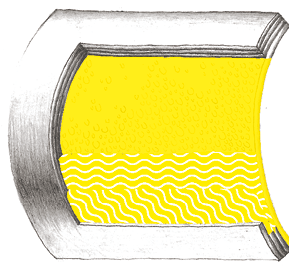In cooperation with Björn, it is splitted on "Disease is Different" into the sections by organ systems and combined with the real cases of our international testimonial / report archive of the related organ system.
SMALL INTESTINE – JEJUNUM AND ILEUM
The jejunum and the ileum together are about 3-5 m (10-17 ft) long. They follow the duodenum and together, the three sections form the small intestine.
The many folds, villi, and their threadlike cell extensions (microvilli) form a gigantic, metabolically active surface of about 60 m2 (> 600 sq ft).
The jejunum and ileum are exclusively composed of endodermal tissue.
Note: Poisoning (antibiotics, etc.) may disrupt untold functions in the small intestine and contribute to many of the SBSs listed here.
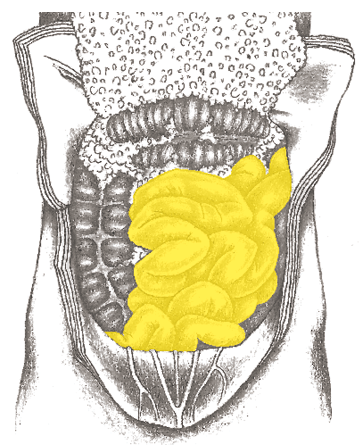
Small Intestine Mucosa
Not being able to digest something, often with
a starvation aspect
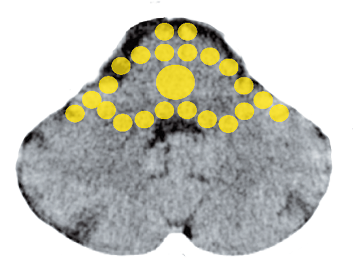
Cancer of the small intestine (adeno-ca), polyps of the small
intestine, tumorous thickening of the intestinal wall1
| Conflict | Chunk conflict (see explanations p. 15, 16), not being able to digest something, often with a starvation aspect. Indigestible-anger. A project or something in which one has invested doesn’t deliver the hoped for use/profit. “One leaves empty-handed.” “One has nothing to show for it.” “One feels that fate is laughing at them.” |
|---|---|
| Examples | ➜ A baby is weaned too suddenly. It believes it will starve since the baby food is unacceptable. A 40-year-old, head secretary unexpectedly finds herself in a very unpleasant situation: She has to tell her boss that a coworker has divulged an important company secret. Afterward, she must face her colleague, as a “whistle-blower“ = indigestible-anger conflict. Two days later, she seeks a clarifying discussion with the colleague = partial resolution of the conflict. However, she has to think of this unpleasant situation every time she sees her = trigger. Since then, the patient suffers from diarrhea and mild night sweats = persistent repair. Through a second conversation with her colleague, she can finally resolve the conflict. (Archive B. Eybl) A 40-year-old, head secretary unexpectedly finds herself in a very unpleasant situation: She has to tell her boss that a coworker has divulged an important company secret. Afterward, she must face her colleague, as a “whistle-blower“ = indigestible-anger conflict. Two days later, she seeks a clarifying discussion with the colleague = partial resolution of the conflict. However, she has to think of this unpleasant situation every time she sees her = trigger. Since then, the patient suffers from diarrhea and mild night sweats = persistent repair. Through a second conversation with her colleague, she can finally resolve the conflict. (Archive B. Eybl) As the result of a stroke, a man is incapable of speaking. He cannot get used to the situation. He was a charismatic person, who was always at the center of things and everyone asked for his advice. Suddenly, he cannot say a word = indigestible-anger conflict > growth of a tumor in the active-phase – according to CM, a “malignant cancer of the intestine.“ (Archive B. Eybl) As the result of a stroke, a man is incapable of speaking. He cannot get used to the situation. He was a charismatic person, who was always at the center of things and everyone asked for his advice. Suddenly, he cannot say a word = indigestible-anger conflict > growth of a tumor in the active-phase – according to CM, a “malignant cancer of the intestine.“ (Archive B. Eybl) |
| Conflict-active | Increased function, growth of a cauliflower-like tumor of secretory quality or a flat-growing adeno-ca of absorptive quality. The cauliflower-like tumor can cause intestinal obstruction (ileus). |
| Repair phase | Tubercular, caseating, necrotizing degradation of the tumor via fungi and bacteria (mycobacteria). Mild fever, night sweats, bleeding, diarrhea, possibly with vomiting if the tumor is situated in the small intestine. If mycobacteria are not present: encapsulation of the tumor. |
| Repair crisis | Chills, heavy bleeding, intestinal spasms, colic due to involvement of the intestinal muscles. |
| Bio. function | Cell proliferation of secretory quality in order to produce more digestive juices to digest the lodged chunk more quickly. Cell proliferation of absorptive quality in order to better absorb the chunk (more efficient use of food). |
| Questions | First, based on the symptoms described, determine if the conflict is active or has been resolved (period without symptoms = active phase. Night sweats, pain, colics = repair phase. If these have lasted for longer than a half a year = recurring conflict. Diagnosed when? (Conflict probably long before this). What can’t I digest/accept? Did I draw the short straw? Starvation situation? (Diagnosis shock, sympathy with someone dying, bankruptcy, theft, emergency situation)? Why did I react so sensitively? Who in the family has had something similar happen? (Research family history). Which beliefs are in the background of the conflict? (E.g., ”Those who have nothing have lost.”) Can I trust myself to leave the old behind me? Which new attitude would have a healing effect? Things that could hinder repair: Are there any advantages in having the disease that I am holding on to? (“Everyone does everything for me now.”) Am I ready to take on the responsibility (with all its consequences)? |
| Therapy | Determine the conflict and conditioning and, if possible, resolve them in real life if they are still active. Guiding principles: “I am at peace with those closest to me and everyone else.“ “We have enough to eat. I am well taken care of.“ Surgery when the passage is obstructed or the polyp or tumor is too large. Better earlier than later, because today, small tumors are diagnosed as “benign“ by CM. > This means less stress for the person concerned. See also: remedies for the colon, p. 255. |
Acute enteritis (inflammation of the small intestine), bleeding – melena (tarry stool)
| Phase | Repair phase or repair phase crisis. Tubercular, caseating, necrotizing degradation of the tumor via acid-resistant fungi and bacteria (mycobacteria). Fever, night sweats, blood in (tarry) stool, usually diarrhea. Caution: blood-thinning medication (anticoagulants) increases the bleeding. |
|---|---|
| Therapy | The conflict is resolved. Support the healing and avoid recurrences. For very heavy bleeding, monitoring via hemogram (blood count) > if necessary, administer transfusions, OP. Schuessler Cell Salt: No. 13. See also: remedies for the colon, p. 255. |
Gluten intolerance (celiac disease), lactose intolerance (lactose malabsorption)
| Phase | Persistent repair. Conflict-triggers gluten or lactose. By long-term degradation and degeneration of the intestinal villi > disrupted uptake of nourishment, causing chronic digestive problems, usually diarrhea, possibly nutritional deficiencies. |
|---|---|
| Example |  A six-year-old boy is sent on a six-week convalescence 400 miles from his parents. The, now, 49-year-old man describes the first two weeks there as “hell.“ The boy is forced to drink milk against his will. Due to this, he partly refuses to eat = conflict of not being able to digest something, indigestible–anger conflict with an aspect of starvation. Trigger = drinking milk. At home, he normally never drinks milk. For 43 years, the patient has suffered from diarrhea whenever he has consumed milk or milk products unknowingly = recurring conflict due to a milk trigger. When he becomes familiar with the 5 Biological Laws of Nature and understands the connection, the conflict is immediately resolved. Since then, the patient can drink a lot of milk without problems. (See www.germanische-heilkunde.at/index.php/erfahrungsberichte) A six-year-old boy is sent on a six-week convalescence 400 miles from his parents. The, now, 49-year-old man describes the first two weeks there as “hell.“ The boy is forced to drink milk against his will. Due to this, he partly refuses to eat = conflict of not being able to digest something, indigestible–anger conflict with an aspect of starvation. Trigger = drinking milk. At home, he normally never drinks milk. For 43 years, the patient has suffered from diarrhea whenever he has consumed milk or milk products unknowingly = recurring conflict due to a milk trigger. When he becomes familiar with the 5 Biological Laws of Nature and understands the connection, the conflict is immediately resolved. Since then, the patient can drink a lot of milk without problems. (See www.germanische-heilkunde.at/index.php/erfahrungsberichte) |
| Therapy | Determine the conflict and conditioning and, if possible, resolve them in real life,so that the persistent repair can come to an end. If no resolution is possible, avoid the offending food (diet). |
“Tromboembolism“ (intestinal infarct)
Same SBS as above, (see pp. 239). According to CM theory, this is the blockage of a blood vessel, which leads to an intestinal infarction. Actually, our blood vessels have a net-like structure and everywhere in the body, there are parallel (collateral) vessels that guarantee the blood supply at all times. These symptoms are probably misinterpreted by CM. However, if a thrombus (clot) is actually found in the angiography, there is probably a tendency toward thromboses in the patient. An indication of this would be thromboses already having been diagnosed at earlier points in time.
| Phase | In the case of an intestinal SBS: repair phase crisis in the context of a repair phase, thus bleeding. Severe edema by syndrome. If it is a blood SBS, see: p.164). |
|---|---|
| Therapy | The conflict is resolved. Support the healing and avoid recurrences! In the case of severe bleeding, monitor the blood count, if necessary, blood transfusions and/or surgery. |
“Fungal infections“ (mycoses) of the intestines (e.g., Candida albicans, aspergillus)
| Phase | Repair phase. Degradation of an adeno-ca via fungi or bacteria (mycobacteria). Flat-growing tumors are not recognized as such in CM because they are spread out widely. |
|---|---|
| Note | Fungi belong to the flora of a healthy human being. In intestinal repair phases, one finds even more of them – if they are verified with a stool analysis, they are called “fungal infections“ in CM. Through the ingestion of sugar, the fungal population is also increased without conflict. |
| Therapy | The conflict is resolved. Support the healing and avoid recurrences. Colloidal silver. See also: remedies for the colon, p. 255. |
“Bacterial infections,“ bacterial intestinal dysentery: typhus or paratyphus bacteria (without salmonella), cholera, Escherichia coli bacteria, campylobacter coli bacteria
In the case of a conflict: same SBS as described on pp. 239. Drinking dirty water, such as water that is contaminated with feces, does not mean getting infected but rather getting poisoned – the body‘s prompt response is one of expulsion: diarrhea, vomiting, sweating. In principle, poisoning does not fall into the area of the 5 Biological Laws of Nature.
| Phase | Repair phase. The difference between poisoning and conflict is often unclear. However, even poisoning isn’t a random event from a cosmic perspective. Everything in life has a reason and a purpose. |
|---|---|
| Therapy | The conflict is resolved. Support the healing and mitigate any conflicts caused by the poisoning. Colloidal silver, MMS. See also: remedies for the colon, p. 255. |
“Viral infections“ of the intestines: ECHO virus, Coxsackievirus, adenoviruses, rotavirus, Norwalk virus, parvovirus
Same SBS as above, (see pp. 239). In CM, the causes of most illnesses are unknown; therefore, pathogens have simply been invented. To this day, not a single virus has been conclusively proven.
| Phase | Repair phase |
|---|---|
| Therapy | The conflict is resolved. Support the repair phase and avoid recurrences. See also: remedies for the colon, p. 255. |
Amoebic dysentery and worm diseases, e.g., bilharziosis (schistosomiasis)
At the University of Iowa, there was great success in the treatment of Crohn‘s disease patients with whipworms. It is possible that worms aid tubercle bacilli during repair phases in the degradation of excess intestinal mucosa. Regardless, doctors at the University of Iowa determined that bacterial flora improves under the influence of worms.
Do amorphous creatures (tape, round, and pinworms) have a specific task – a biological purpose?
Is it possible that an “attack“ by worms is no coincidence, and that it may even be beneficial?
Does it only affect people who need it?
My experience would lead me to say yes.
| Conflict | Morsel conflict, getting too little love or not being able to accept love. (Food is the energy of life in its material form). |
|---|---|
| Conflict active | Worms are not microorganisms/microbes, but are parasites that can live in the human body. In my experience, worms, unlike microbes, appear during the conflict-active phase or during persistent conflicts. In principle, they can only settle somewhere if the terrain is suitable. (Bechamp: “The microbe is nothing; the terrain is everything.”) Symptoms: Anal itching or burning, abdominal pain, abnormal stool, general symptoms such as fatigue, problems concentrating. |
| Bio function | Intestinal worms probably metabolize components in food that would otherwise remain undigested. |
| Repair/healing | With conflict resolution/internal balance, the intestines can once again manage their tasks entirely on their own > the parasites become superfluous and disappear because the terrain is no longer suitable. |
| Examples |  Case example of my own cat: 10 years ago our neighbor was looking for homes for a litter of cats. We decided to delight our old cat “Vicki” with a kitten – we named her “Babsi.” Unfortunately, Vicki was mercilessly dominant towards Babsi – the two never became friends. At the age of three, Babsi started to excrete worm segments (probably a tapeworm) almost daily. The repeated administration of deworming drugs didn’t help – within two weeks the worms were already back. Since that didn’t help, we didn’t want to torture Babsi with any more chemicals, so we let the worms be worms. Four years ago, Vicki died and we noticed how Babsi came into her own: With her raised tail, she confidently roams through the gardens and the woods. Inside, she doesn’t have to worry about being chased away from her favorite places. She developed a much friendlier nature because she feels good all around (= healing phase or normotonia). Ever since Vicki died, Babsi is worm-free, even though she still eats a lot of mice. (Archive B. Eybl) Case example of my own cat: 10 years ago our neighbor was looking for homes for a litter of cats. We decided to delight our old cat “Vicki” with a kitten – we named her “Babsi.” Unfortunately, Vicki was mercilessly dominant towards Babsi – the two never became friends. At the age of three, Babsi started to excrete worm segments (probably a tapeworm) almost daily. The repeated administration of deworming drugs didn’t help – within two weeks the worms were already back. Since that didn’t help, we didn’t want to torture Babsi with any more chemicals, so we let the worms be worms. Four years ago, Vicki died and we noticed how Babsi came into her own: With her raised tail, she confidently roams through the gardens and the woods. Inside, she doesn’t have to worry about being chased away from her favorite places. She developed a much friendlier nature because she feels good all around (= healing phase or normotonia). Ever since Vicki died, Babsi is worm-free, even though she still eats a lot of mice. (Archive B. Eybl)  A 4-year-old girl of a farming family passed an approx. 15 cm (6 in) long and 5 mm (1/4 in) thick, earthworm-like roundworm one day. In the months leading up to this – nobody suspected that she had guests in her intestines – the little girl had only occasionally complained of a burning sensation and her stools had also been unusually light-colored and malodorous (= active phase). Two weeks before the worm was passed, her stools became normal again (= indication of intestinal regeneration). The last six weeks before she passed the worm had been exceptionally beautiful for the whole family: The Corona-lockdown had provided some time for a quiet, simple and somehow fulfilling family-life experience. They were all doing really well: The mother related that a vaginal mycosis she had for years went away, their 2-year-old daughter got over a chronic case of croup, and our little patient was rid of her intestinal-anal worm complaints (= big family healing phase). Summary: The conflict, that the little one wasn’t getting enough love – perhaps due to the parents’ increased attention to her younger sister who was always coughing – was resolved. > The worm was no longer satisfied with the terrain and it moved on. The parents are familiar with the New Medicine and, after their child experienced a brief shock, they decided not to go to the doctor. Afterward, the little one was better than ever. (Archive B. Eybl) A 4-year-old girl of a farming family passed an approx. 15 cm (6 in) long and 5 mm (1/4 in) thick, earthworm-like roundworm one day. In the months leading up to this – nobody suspected that she had guests in her intestines – the little girl had only occasionally complained of a burning sensation and her stools had also been unusually light-colored and malodorous (= active phase). Two weeks before the worm was passed, her stools became normal again (= indication of intestinal regeneration). The last six weeks before she passed the worm had been exceptionally beautiful for the whole family: The Corona-lockdown had provided some time for a quiet, simple and somehow fulfilling family-life experience. They were all doing really well: The mother related that a vaginal mycosis she had for years went away, their 2-year-old daughter got over a chronic case of croup, and our little patient was rid of her intestinal-anal worm complaints (= big family healing phase). Summary: The conflict, that the little one wasn’t getting enough love – perhaps due to the parents’ increased attention to her younger sister who was always coughing – was resolved. > The worm was no longer satisfied with the terrain and it moved on. The parents are familiar with the New Medicine and, after their child experienced a brief shock, they decided not to go to the doctor. Afterward, the little one was better than ever. (Archive B. Eybl) |
| Questions | First symptoms when? (The conflict can be found beforehand) What stressed me at this time? Which new issue arose in my life? Children: What changed in the life of the family/in the parents’ relationship? Did another sibling arrive on the scene? Did mommy have to go to work? Does the child have a feeling of not getting enough love/affection, enough attention? |
| Therapy | Determine and resolve the conflict, causal conditioning and belief structures. Strengthen the intestines, optimize nutrition, see remedies for the colon p. 255. If nothing helps, possibly CM worm remedies (antihelmintics). |
1 See Dr. Hamer Charts pp. 22, 27
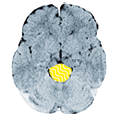
Constipation, diarrhea, intussusception (one segment folding into another – invagination), twisting around itself (volvulus)
In cases where there is no poisoning with medication (e.g., with morphine):
| Conflict | Motor chunk conflict (see explanations p. 15, 16), not being able to move something further (in real life or figuratively). Something does not come through. Topic standstill, stagnation or too many tasks simultaneously. Constipation: Something/a matter is not yet completely digested (awaiting a solution/resolution) or one wants to hold something back. |
|---|---|
| Example | ➜“It won’t budge.” “I can’t keep things moving forward.“ “Not that too!” The 33-year-old son of a 70–year–old farmer still does not know if he wants to take over the farm. The farmer (our patient) postpones any decisions – the operation and the family are stagnating. = Conflict that nothing can be moved forward. Since this situation has come to a stand-still the farmer suffers from constipation and always has to burp. (Archive B. Eybl) The 33-year-old son of a 70–year–old farmer still does not know if he wants to take over the farm. The farmer (our patient) postpones any decisions – the operation and the family are stagnating. = Conflict that nothing can be moved forward. Since this situation has come to a stand-still the farmer suffers from constipation and always has to burp. (Archive B. Eybl) A 45-year-old construction foreman has to be at multiple construction sites at the same time he has “too many irons in the fire.” On these days, he has to loosen his belt because his belly gets so fat. (Archive B. Eybl) A 45-year-old construction foreman has to be at multiple construction sites at the same time he has “too many irons in the fire.” On these days, he has to loosen his belt because his belly gets so fat. (Archive B. Eybl) |
| Conflict-active | Conflict–active Increased tension in the longitudinal, intestinal muscle > limitation of the peristalsis, tense, swollen abdomen, stomach ache, constipation/diarrhea (see also: p 207ff). If nothing is happening or too much is happening at once, it is often accompanied by inner anxiety, restlessness or turmoil. |
| Repair crisis | Colic, sudden onset of diarrhea, pain or also the desire to be able to defecate. |
| Repair phase | Increased tension in the transverse muscles. Stomach back to normal, constipation/diarrhea. Invagination In this disease, a part of the intestine pushes into another. A segment remains in sympatheticotonia (extension), the other in parasympatheticotonia (narrowing). In healthy peristaltic contraction, waves flow through the whole intestine (longitudinal waves and transverse waves). The phase is unclear. OP if necessary. • A young woman has a job as a pedicurist. Unfortunately, her hard work is not recognized by her boss. Often, she is paid late, which leads to disputes. = Conflict that things aren’t moving forward professionally. At this time, she suffers an acute intestinal obstruction due to an intussusception, which isn’t recognized immediately. The affected section of the intestine is removed surgically. (Archive B. Eybl). Volvulus Slackening of the involuntary intestinal musculature and subsequent twisting of the intestine around its own axis > danger of intestinal occlusion or demise of the intestinal tissue (intestinal gangrene) caused by the blockage. OP if necessary. |
| Questions | Where am I stagnating? What isn’t fully digested? What don’t I want to give up? Why? Conditioning? |
| Therapy | Determine the conflict and conditioning and, if possible, resolve them in real life. See also: remedies for the colon p. 255. |
All experience reports on the organ system „Small Intestine – Jejunum and Ileum” from the International Report Archive:
| Author | Title and Overview | Keywords | ||||||||||||||||||||||||||||||||||||||||||||||||||||||||
|---|---|---|---|---|---|---|---|---|---|---|---|---|---|---|---|---|---|---|---|---|---|---|---|---|---|---|---|---|---|---|---|---|---|---|---|---|---|---|---|---|---|---|---|---|---|---|---|---|---|---|---|---|---|---|---|---|---|---|
 | 2025/01/30   A client came with a diagnosis of chronic, incurable ulcerative colitis and a recommendation to have her small intestine removed. Three months after our intensive collaboration, she had no symptoms and had slowly stopped taking all her medication. She declared herself cured. | Ulcerative colitis | ||||||||||||||||||||||||||||||||||||||||||||||||||||||||
 | 2025/01/21   Vomiting diarrhea due to operating costs bill | Vomiting diarrhea | ||||||||||||||||||||||||||||||||||||||||||||||||||||||||
 | 2024/12/04   At the age of 21, the patient had her first severe intestinal inflammation, requiring a long hospital stay and massive intake of cortisone. Since then, she has had diarrhea of varying intensity, abdominal pain (inflammation) and a bloated, board-hard stomach after eating. | |||||||||||||||||||||||||||||||||||||||||||||||||||||||||
2024/11/13   I have known for years that an important update to a software would be required at some point. I had prepared everything for this, except for the outsourcing of texts to so-called properties files for translations. This work has been left undone for more than 5 years and meant days of mindless searching, copying and pasting. | ||||||||||||||||||||||||||||||||||||||||||||||||||||||||||
2024/11/05   Congratulations to a friend of one of our course participants (with a successful allergy resolution). Together they were able to find the cause of her intolerance and resolve it too! Congratulations and thank you very much for sharing this valuable experience!  | ||||||||||||||||||||||||||||||||||||||||||||||||||||||||||
 | 2024/07/21   An event that made several SBSs necessary. | cold sweats, left ventricular myocardial infarction, nauseous diarrhea, chills, night sweats | ||||||||||||||||||||||||||||||||||||||||||||||||||||||||
 | 2024/03/31   The tax office sent me a notification about a letter delivered to the service portal. On Friday evening, of course. However, the service portal was no longer accessible to me, as I am no longer self-employed. So, I couldn’t access the letter. Over the weekend, I became increasingly anxious and worried... | |||||||||||||||||||||||||||||||||||||||||||||||||||||||||
2023/11/23   This video is about the causal event that led to "hay fever" and the various food allergies that gradually built on this. And, of course, the resolution by recognizing the causal connections! Congratulations on the successful resolution and many thanks for sharing this wonderfully instructive experience report (in german, but you can activate english subtitles)! 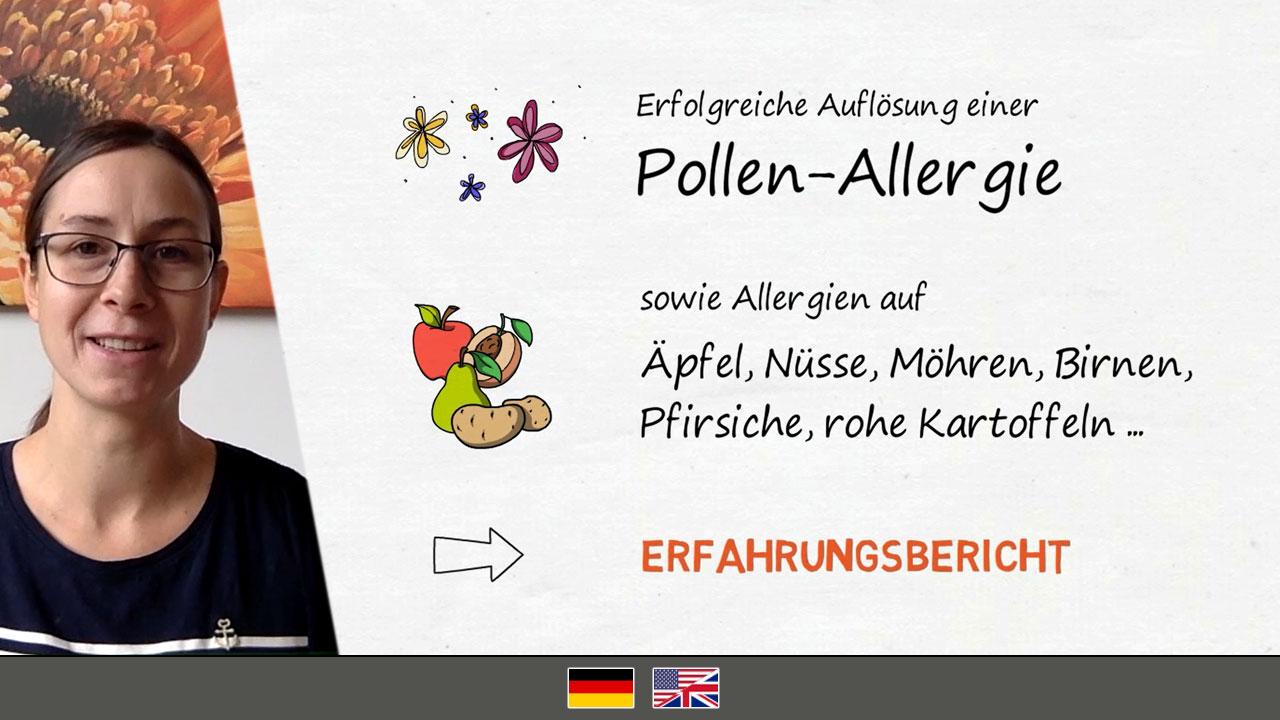 | ||||||||||||||||||||||||||||||||||||||||||||||||||||||||||
 | 2023/08/01   A woman (30, female hormone, right-handed) had been lactose intolerant for 15 years with symptoms of the small intestine (indigestible annoyance with the aspect of starvation). | allergy | ||||||||||||||||||||||||||||||||||||||||||||||||||||||||
2023/04/15   Gunter speaks in this testimonial video about his successful resolutions of various suture intolerances (gluten, various meats, tomatoes, peanuts, raisins, and more) based on the 5 Biological Laws of Nature. Congratulations and thank you very much for this wonderful report! 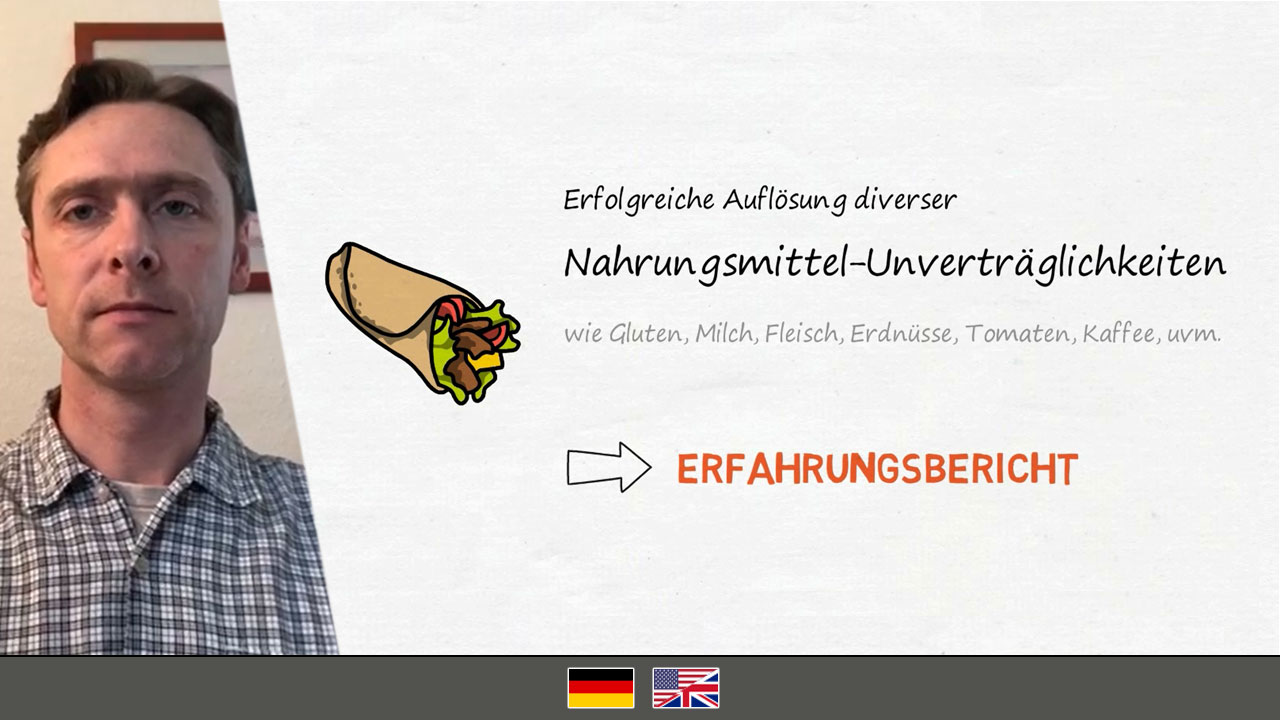 | Track, resolving allergies, resolving intolerances | |||||||||||||||||||||||||||||||||||||||||||||||||||||||||
 | 2023/04/10   When the PLANdemie was announced on Swiss television in March 2020, I knew immediately that it was a lie and a scam. My key sentence was: “They want to sell us the vaccine.” That was the start of the agitation and mistrust against me ... | |||||||||||||||||||||||||||||||||||||||||||||||||||||||||
2022/10/08    A good friend and I had opinions and positions during the Corona period that could not have been more different. However, since we had not seen each other for more than a year during that time, we arranged to meet a few months later (winter 2021). At that time, his wife was pregnant. ... | "Indigestable anger" conflict, ileum, lower small intestine | |||||||||||||||||||||||||||||||||||||||||||||||||||||||||
2022/05/25   These are the testimonials (in short) about the next six successfully resolved allergies of the participants of our practice course "Resolving Allergies". The reports are available as text and video. 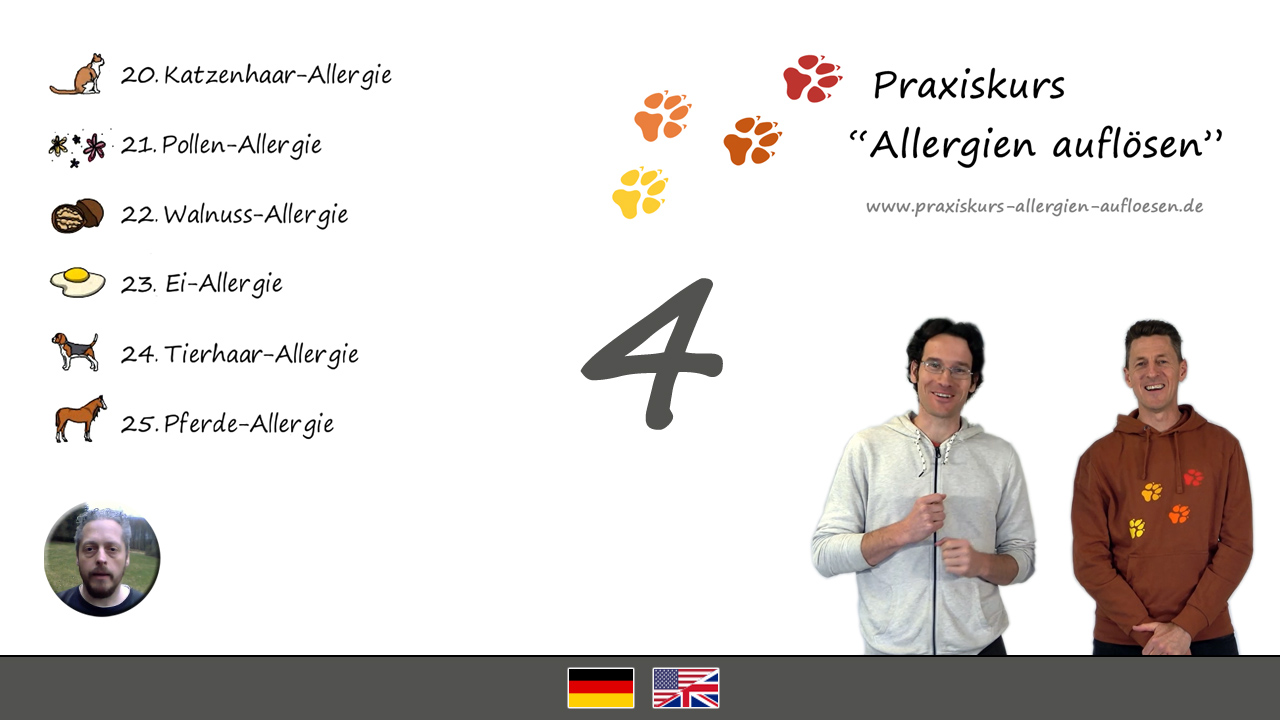 | Track, resolving allergies | |||||||||||||||||||||||||||||||||||||||||||||||||||||||||
2021/09/07   These are the testimonials (in brief) about the next six successfully resolved allergies of the participants of our practice course "Resolving Allergies". The reports are available as text and video (the video is in german, but has english subtitles). 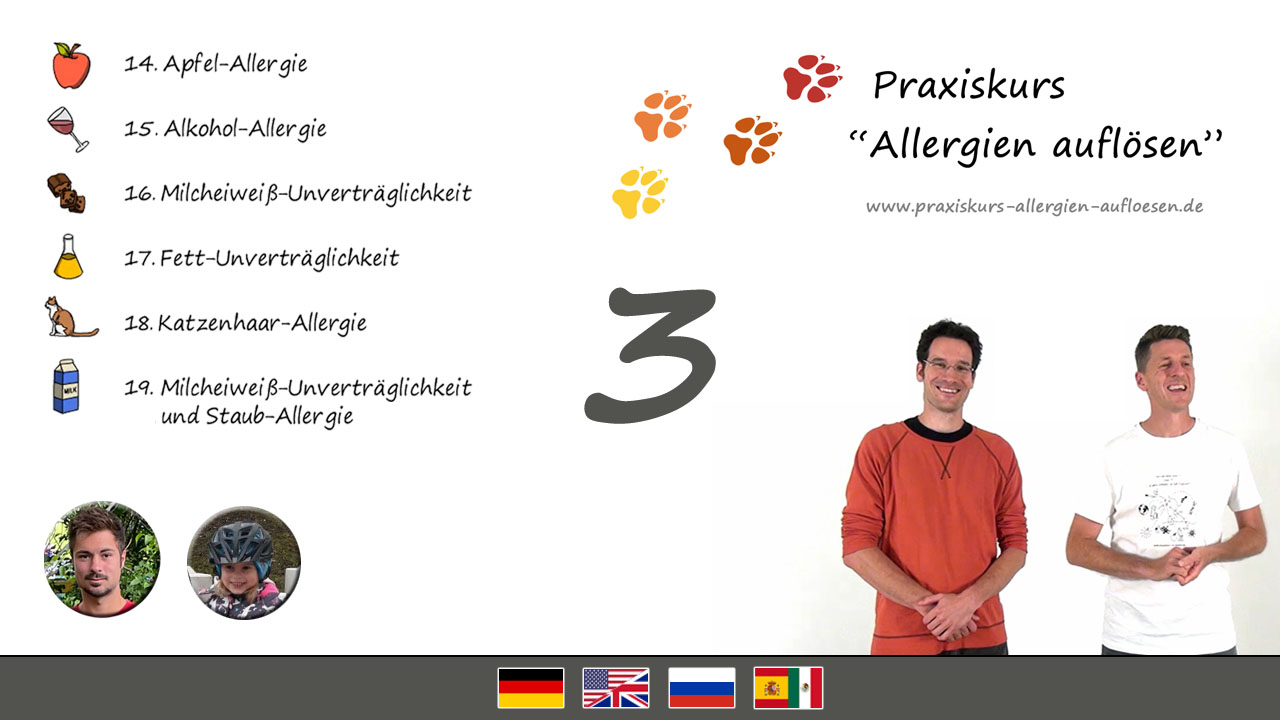 | Track, resolving allergies | |||||||||||||||||||||||||||||||||||||||||||||||||||||||||
2021/08/20    These are the testimonials (in brief) about the next six successfully resolved allergies of the participants of our practice course "Resolving Allergies". The reports are available as text and video (the video is in german, but has english subtitles). 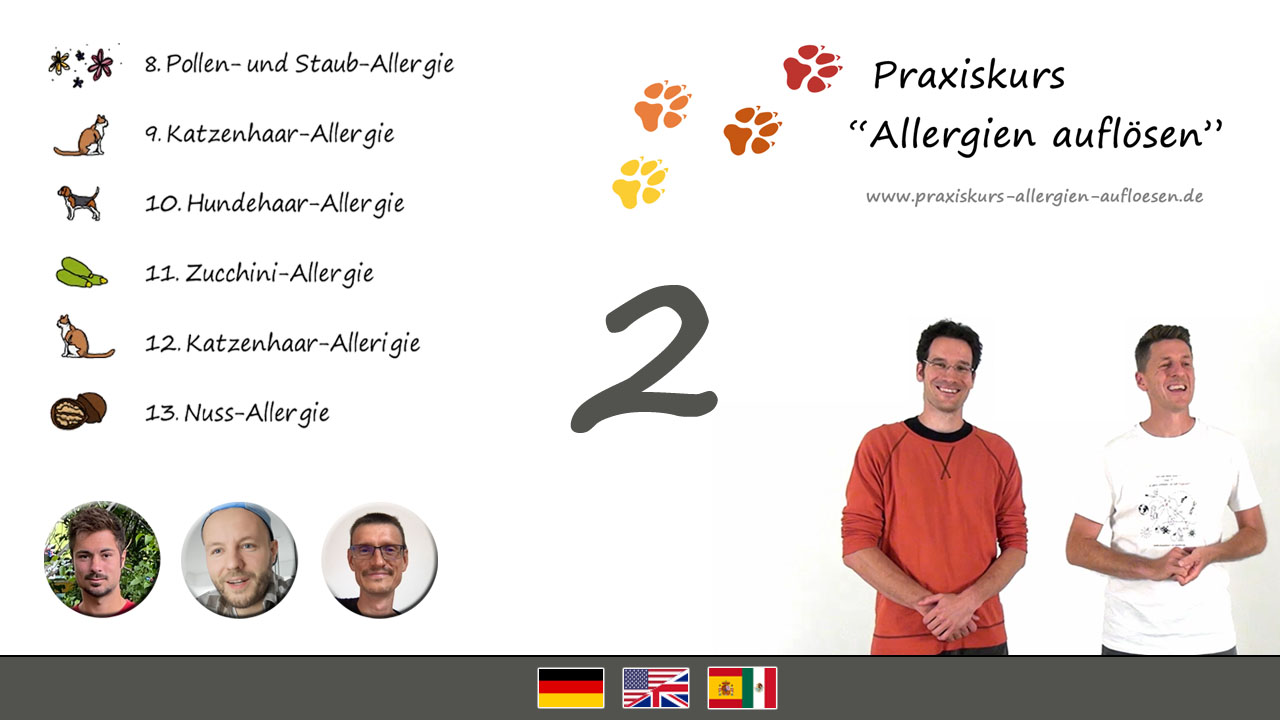 | Track, resolving allergies | |||||||||||||||||||||||||||||||||||||||||||||||||||||||||
2021/06/30    These are the testimonials (in brief) of the first seven successfully resolved allergies of the participants of our practice course "Resolving Allergies". The reports are available as text and video (the video is in german, but has english and spanish subtitles): 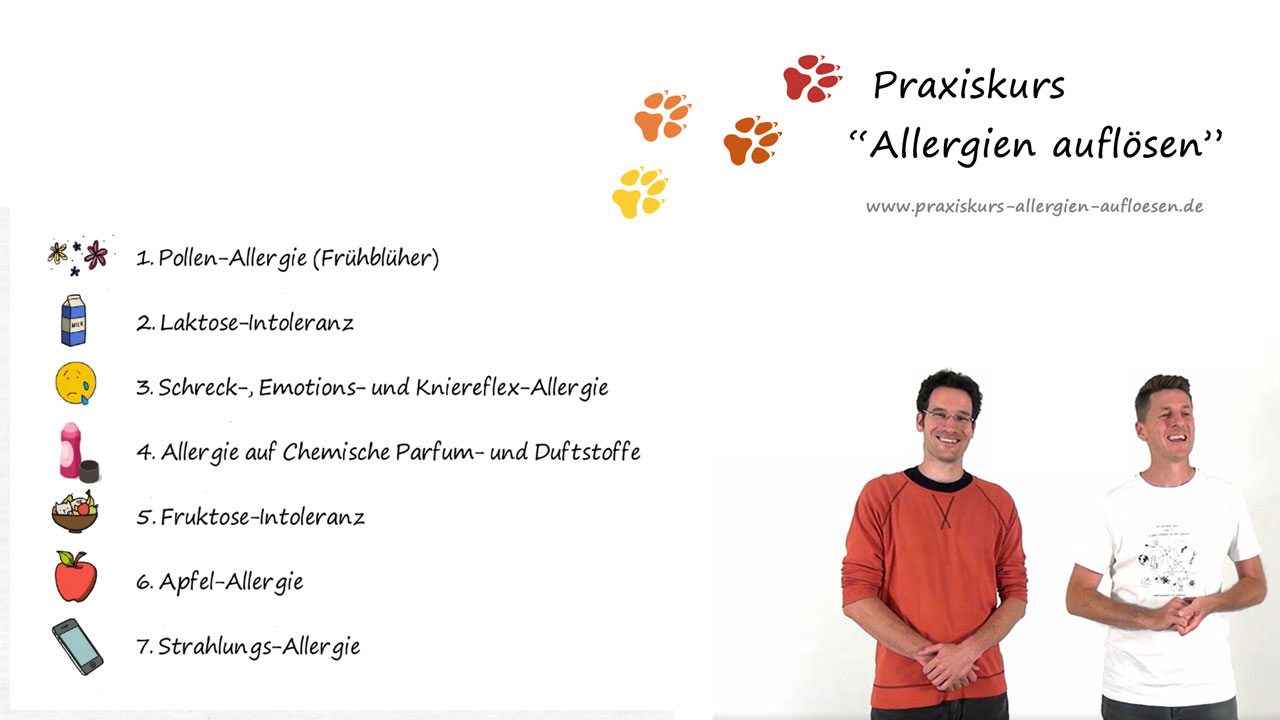 | Track, resolving allergies | |||||||||||||||||||||||||||||||||||||||||||||||||||||||||
2018/01/30     A young woman could not drink apple juice or eat apples for many years because she reacted with diarrhea as a direct result. By knowing the cause, the allergy could be resolved with a simple experiment. | ||||||||||||||||||||||||||||||||||||||||||||||||||||||||||
2015/05/24      Successful conscious resolution of an allergy to black pepper that had existed for more than 40 years. Just by knowing the cause and becoming aware that the danger of that time is no longer present and the linking of the track is no longer necessary. |

